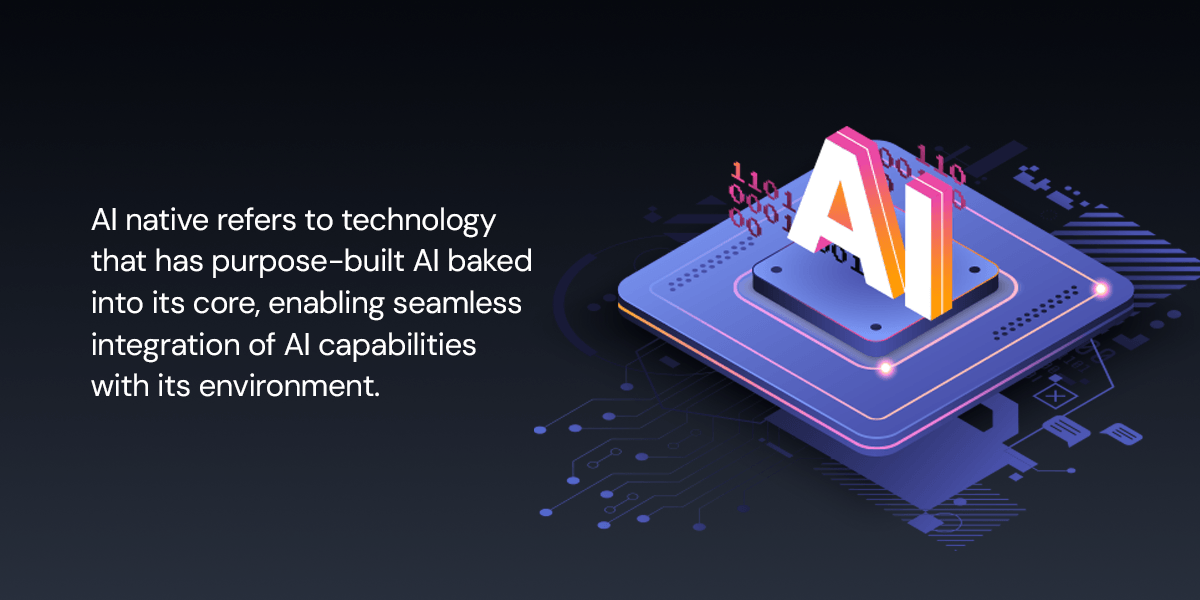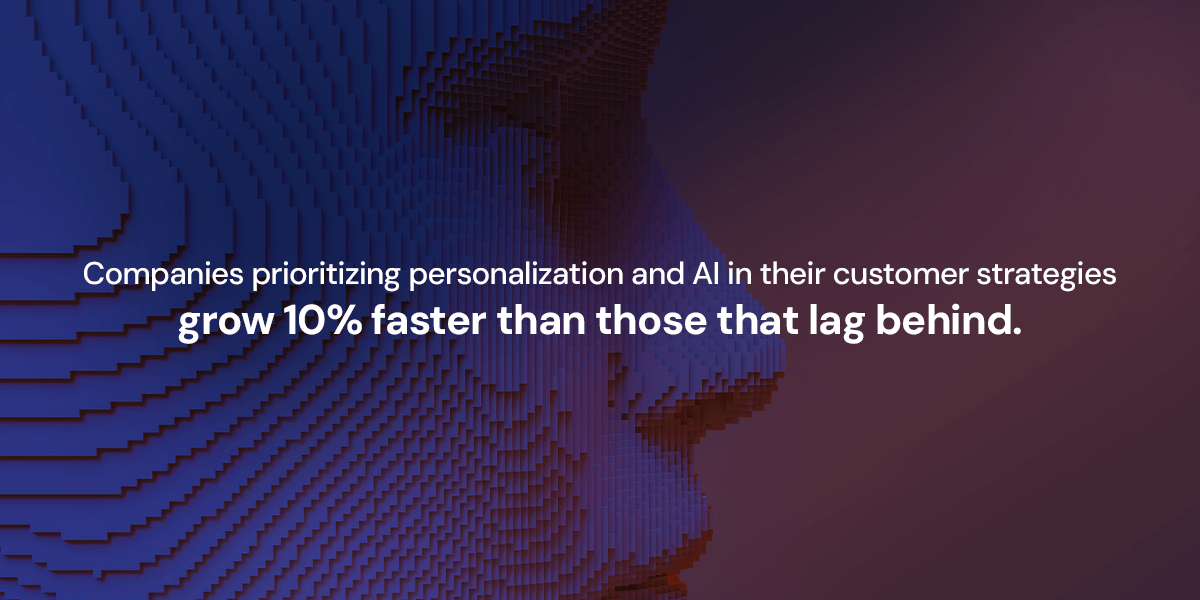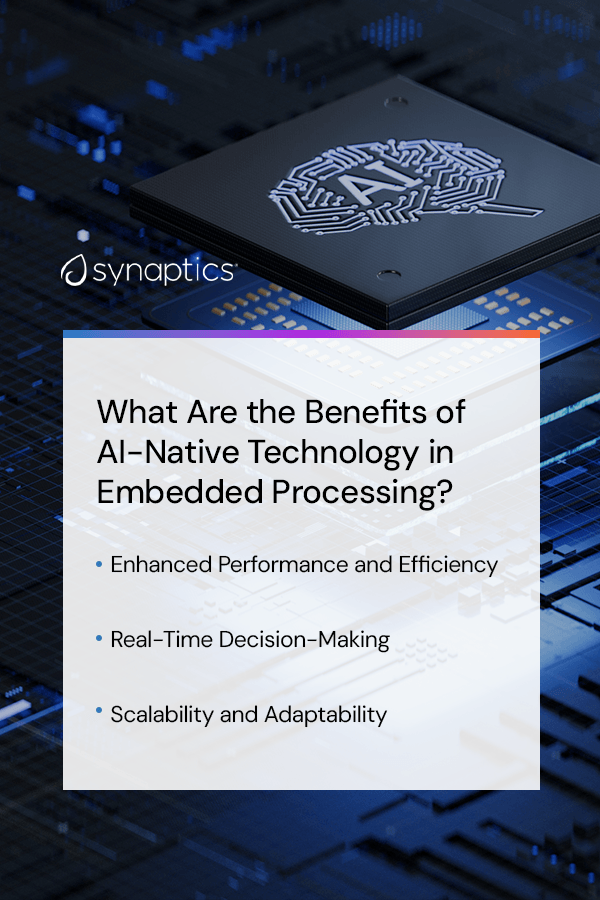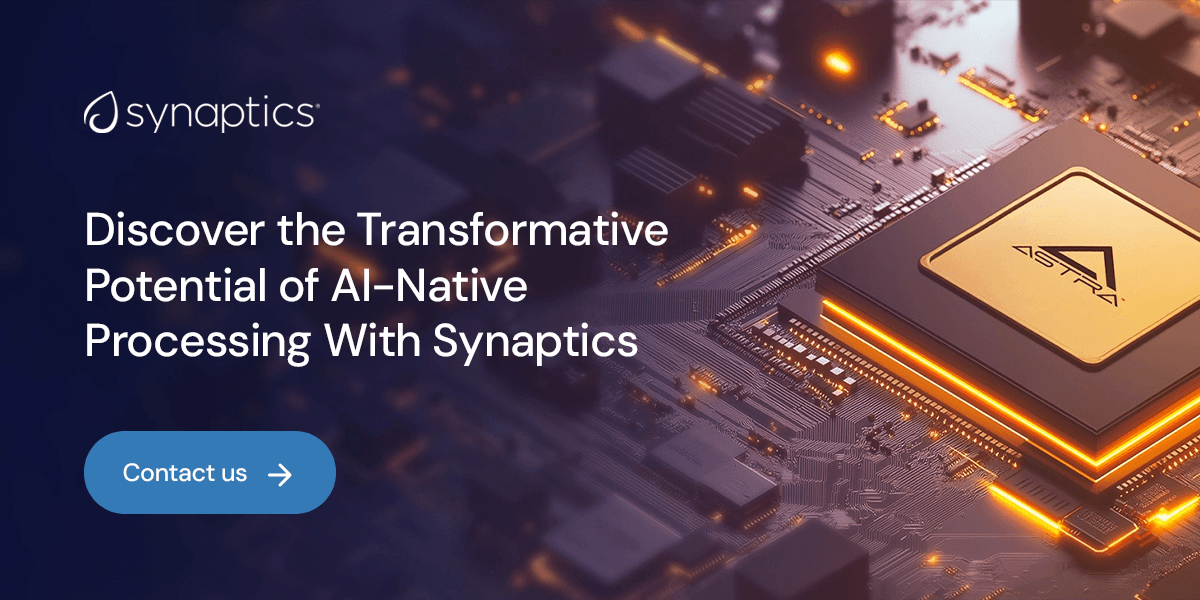-
Search
Search
Experiential
Computing
Blog
AI Native — What Does It Mean for Embedded Processing?
Mar 27, 2025
By Neeta Shenoy

Artificial intelligence (AI) continues transforming how users interact with technology. AI-powered chatbots like ChatGPT, along with advancements in data analytics and mobile technology, have contributed to high expectations among tech users. Consumers want and expect faster, more personalized, and smarter experiences — whether they're controlling a smart home device or speaking to a chatbot on a retailer's website.
Forward-thinking companies consider AI in product development to meet the demand for intelligent devices. In other words, innovative businesses harness the power of AI-native technology.
What Does AI Native Mean?
AI native refers to technology that has purpose-built AI baked into its core, enabling seamless integration of AI capabilities with its environment. By contrast, traditional AI is generally located on processors outside of the device, like servers or the cloud, and may be added as an afterthought. While traditional AI can process massive datasets thanks to its greater processing power, it's not as intuitive as native AI.
For example, an AI-native photo application will know to present photos of your car if you search the word “car” — even if you have never tagged your photos. It already knows how to recognize car images because it's been trained through machine learning techniques.
A photo app that has been retrofitted with AI will likely require more steps than typing in a search term. For instance, the user may need to toggle on an AI setting or enter a separate module to access AI features. These added steps make the experience more time-consuming and less intuitive.

What Is AI-Native Processing in Embedded Systems?
Embedded systems are specialized computers designed for a specific purpose and function within a larger system. They usually include sensors, software, and a computer chip such as a microprocessor or microcontroller unit. These computer systems are embedded into the devices they control or monitor. You'll find embedded systems in a vast range of products, from medical devices to robotic vacuum cleaners.
AI-native technology can be integrated with embedded systems, allowing devices to perform more advanced tasks. AI-native processing is the method an AI processor uses to analyze data and make decisions based on its analysis. The process begins with data input, which may be collected through a sensor or user interaction. The AI processor then runs the model it is programmed to use — such as a neural network — to perform intelligent tasks like speech recognition or object classification. It'll then trigger an action or communicate with another system.
For example, a security camera with an embedded AI processor can identify a person and classify them as an intruder. Once it detects an intruder, it can trigger an alarm.
Another example is a smart shelf in a retail store that uses an embedded processor with AI capabilities built in. AI-native smart shelves can track and analyze inventory data in real time, helping managers efficiently decide whether to restock products. AI-native smart shelves that integrate with digital signage can intelligently adapt pricing or product information based on inventory levels.
What Is the Role of Edge AI in AI-Native Processing?
Edge AI refers to AI processing that occurs locally on a device near the source of data collection. A smartphone with embedded AI processing is an example of edge AI because it gathers and processes user data intelligently directly within the device that contains it. Edge AI removes the need to transmit data to a distant location like the cloud, enabling near-immediate data processing.
Edge AI is an important component of the Internet of Things (IoT) because it increases the reliability, responsiveness and efficiency of connected devices. Edge AI also enhances the security of IoT devices since it doesn't require sending personal information to remote servers for processing, protecting the data from interception.
Many edge solutions are AI-native because they are purpose-built to perform edge AI processing. For example, an AI-native smart thermostat is designed with AI capabilities, and it functions as an edge device. It processes data like room temperature or humidity levels locally and adjusts itself in real time based on user preferences.
Many types of AI-powered edge devices are leveraged for advantages like real-time decision-making. For instance, industrial machines can respond to temperature changes as they occur with edge AI, which is crucial for ensuring consistent operation. Another example is how health care professionals can use edge devices like heart monitors to collect real-time information on patient health and identify potential issues early.
What Are AI-Native Applications?
Rapid innovations in hardware and software continue to enhance AI performance and bring more opportunities to implement AI-native technologies. Here are a few AI-native applications that may be used in nearly any industry to enhance the user experience.
AI-Native Networking
Network issues are not unheard of in the business world. According to a 2024 report, nearly 60% of multisite businesses experience a network outage every month. For organizations in high-risk industries like health care or government, where patient lives or national security are on the line, a network outage can be a serious problem.
AI-native networking can decrease the risk of a connectivity issue because its AI capabilities are built directly into the networking system, enabling it to respond to user needs in real time. An AI-native network can optimize traffic routing and manage bandwidth based on user requirements, making network performance and connectivity faster, more reliable and more responsive.
As the network platform accumulates more data and continually learns, it becomes more efficient and better at analyzing and predicting network behavior. It can anticipate and proactively address traffic increases or efficiently self-correct and reroute traffic if an issue arises. AI-native networking can be implemented in any industry to connect everything from consumer IoT devices to patient monitoring systems.
AI-native networking is also an ideal solution for companies ready to scale. A well-trained AI-native network is less likely to lose performance quality or efficiency as traffic increases, allowing organizations to manage busy networks in a cost-effective way.
AI-Native Software and Apps
In a recent survey of over 5,000 global consumers, over 80% of respondents say they expect and want more personalized experiences. Some companies, like Netflix and Amazon, are leaders in harnessing generative AI to deliver more personalization to their customers. Companies prioritizing personalization and AI in their customer strategies grow 10% faster than those that lag behind.

How does AI make a difference? Unlike outdated legacy systems, AI technology is not static. It continually evolves and improves based on user interactions, allowing software and applications to meet dynamic user needs. For example, businesses can use AI-integrated customer relationship management software to analyze customer data, predict their needs, and make strategic product- or service-related decisions efficiently.
Meanwhile, consumers can use AI-powered personal assistants tailored to their needs and preferences to manage smart home devices with greater convenience. They can also use AI-native health applications to get personalized recommendations based on their behavior patterns and health goals.
Overall, AI-native solutions have the potential to make users' lives easier and more aligned with personal and professional goals. Businesses and consumers alike can utilize AI-native technology to automate repetitive tasks, personalize the user experience and facilitate better decision-making.
AI-Native IoT Devices
AI-native IoT devices feature AI capabilities integrated into their hardware, software and connectivity. They can utilize complex algorithms to learn from user interactions and preferences and refine their functionalities accordingly. This capability goes beyond those of traditional IoT devices, such as basic fitness trackers or smart home appliances, which require manual programming to adapt to the user.
Innovations in AI technology are allowing developers and engineers to design AI-native technology that matches the power, space and functionality requirements of IoT devices like appliances, wearables and more. For instance, IoT engineers can use purpose-built chips to enable low-power needs and scalability in AI-native IoT devices. Additionally, AI-native IoT devices designed to perform edge computing can function without constant internet connectivity — which can be vital in industries requiring consistent IoT device performance.
Many IoT devices still rely heavily on cloud connectivity to perform AI tasks, but AI-native technology and edge computing are defining the next generation of IoT. We can expect to see an increasing number of IoT devices equipped with AI capabilities and edge computing in the near future.
What Are the Benefits of AI-Native Technology in Embedded Processing?
AI is accelerating innovation across services, products and business operations, and most companies know they need to keep pace. Therefore, it's unsurprising that 92% of companies plan to increase their investments in AI over the next three years, according to a 2025 McKinsey report. AI-native technology in embedded processing is an important facet of the AI revolution because it has the potential to offer the following significant advantages.

Enhanced Performance and Efficiency
AI-native processing in embedded systems is purposely designed to function optimally within a specific device, machine or appliance. AI-native, on-device processing does not require transmitting data to the cloud and waiting for remote servers to process the data and send it back. As such, the device responds to data inputs immediately and performs machine learning functions much more efficiently. AI-native systems may also be designed with streamlined algorithms, reducing power needs.
Locally based data processing, such as that in edge devices, can minimize energy consumption — especially in battery-powered devices — because they don't need to send data afar. If AI-native devices utilize AI-native networking, users can allocate computational resources according to workload needs in real time and reduce energy waste.
Real-Time Decision-Making
AI-native technologies use sophisticated algorithms and data management techniques to process and analyze large datasets in real time and provide near-immediate results. Businesses can use AI-native technology to quickly accomplish various tasks, from determining customer preferences to identifying security risks. With these immediate insights, leaders can make strategic, proactive decisions vital for mitigating risks or outpacing competitors.
Scalability and Adaptability
Scalable businesses are equipped to seamlessly handle increasing workloads so they can grow when demand for their products or services surges. A company should also be able to adjust its resources efficiently when demand decreases to prevent waste and budget overruns. Achieving long-term scalability and adaptability requires scalable and adaptable technology — like AI.
AI-native systems feature built-in flexibility, allowing businesses to evolve with changing workload needs. That's because AI continually updates its model with new data and learns from these updates — it's never static. AI-native solutions can optimize resources based on user needs, regardless of whether the workload increases or decreases, without compromising quality performance or bandwidth efficiency.
What Are Some Challenges With AI-Native Processing?
As with any technological advancement, AI-native processing comes with a few challenges:
Technical Challenges
AI-native technology poses various technical challenges for businesses that may be deeply intertwined with outdated legacy systems or lack the skill sets to deploy AI-native solutions in their products or equipment. For example, some original equipment manufacturers (OEMs) might specialize in producing components that aren't inherently designed to integrate with AI.
To overcome the technical challenges of implementing AI-native technology, OEMs and other businesses may need to redesign their products to be more adaptable. That said, it's important to identify your goals and objectives for integrating AI-native capabilities and determine if adding AI is the best move for your company. If the answer's yes, identify skill gaps among your engineers and determine steps to address them, whether that means training employees or hiring a technology partner.
Perceived Security Concerns
AI technology feels new to many people, so security is a common concern for AI users. For example, according to McKinsey, 51% of U.S. employees say they're concerned about cybersecurity risks associated with generative AI.
One particular concern is that the technology might expose sensitive data. Since generative AI is trained on large datasets, there's a risk it'll incorporate sensitive information during training and reveal this data in its outputs.
AI-native solutions do not pose the same level of risk as generative AI. AI-native technology is purpose-built to function within a more controlled computing environment for specific applications. In other words, AI-native applications have a smaller attack surface — or fewer pathways for unauthorized access. AI-native solutions may also include unique security features, enhancing their protection against cyberthreats.
Still, like most forms of technology, any type of AI can be vulnerable to cybersecurity threats. To address AI security concerns, government agencies must develop and enforce AI security policies, while organizations need to ensure staff members receive training on secure AI deployment. Businesses can also create a culture of good cybersecurity and form relationships with reputable tech partners to protect themselves against a range of security threats.
Cost and Development
Developing AI-native solutions can come with high upfront costs related to investing in new hardware, software, research and development, and employee training. Integrating AI with existing systems can also be a technically complex process, potentially requiring redesign, prototyping, testing and hiring an external organization for technical support.
Nevertheless, investing in AI is necessary for many businesses to stay relevant. Companies can implement AI-native technologies in phases and begin with small-scale projects, focusing on those with the highest ROI potential. Businesses should also consider partnering with a tech company experienced in AI-native processing to ensure a smooth transformation.
Discover the Transformative Potential of AI-Native Processing With Synaptics
Businesses across many industries, from health care to home appliances, must keep up with increasing amounts of data processing while meeting consumer demands for efficient, personalized and high-performing products or services. By choosing or designing products that integrate AI natively, organizations can open the door to innovation, growth and future readiness.
Are you ready to unlock the power of AI-native processing? We can help. At Synaptics, we engineer and manufacture high-performing, purpose-built AI technologies for OEMs, original design manufacturers and any company developing cutting-edge technology products. For example, Synaptics Astra™ is our embedded processor designed to seamlessly bring AI-native capabilities to IoT devices. We also offer ultrareliable, low-power wireless solutions optimized for IoT.
Discover how we can help your business embrace and harness AI-native solutions for maximum impact. Contact us today.

About the Author
